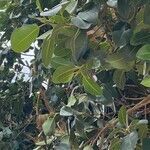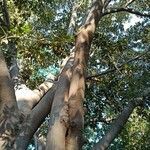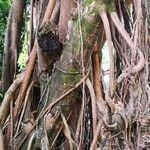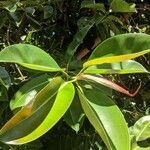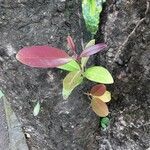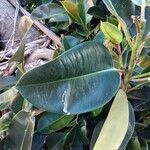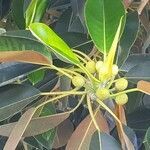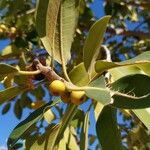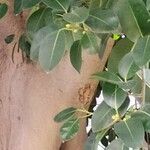Trees, 20-30 m tall, d.b.h. 25-40 cm, epiphytic when young. Bark pale gray, smooth. Branchlets strong. Stipules dark red, ca. 10 cm, membranous; scar conspicuous. Petiole robust, 2-5 cm; leaf blade oblong to elliptic, 8-30 × 7-10 cm, thickly leathery, abaxially pale green, adaxially dark green and shiny, base broadly cuneate, margin entire, apex acute; secondary veins many, closely parallel, inconspicuous. Figs axillary on leafless branchlets, paired, yellowish green, ovoid-ellipsoid, ca. 10 × 5-8 mm, subsessile; involucral bracts hoodlike, caducous, scar conspicuous. Male, gall, and female flowers within same fig. Male flowers: scattered among other flowers, pedicellate; calyx lobes 4, ovate; stamen 1; filament absent; anther ovoid-ellipsoid. Gall flowers: sepals 4; ovary ovoid, smooth; style subapical, curved. Female flowers: sessile; style persistent, long; stigma enlarged, ± capitate. Achenes ovoid, tuberculate. Fl. winter.
A fig. It is an evergreen tree. It grows to 30-60 m high and spreads to 10-60 m across. The trunk can be 25-40 cm across. The stem is erect and stout. It can have buttresses. The bark is pale grey and smooth. It can grow on other plants when young. The tree has a rounded crown. It produces aerial roots which hang down and later become prop roots. It also has an aggressive root system. The leafy growth at the base of a leaf is red and 10 cm long. It leaves an easy to see scar. The leaves are green and glossy. Often new leaves have a red flush. They are oblong and 30-45 cm long. They are leathery and have prominent veins. On fruiting branches of mature trees the leaves are smaller. The fruit are greenish-yellow figs. These are 1 cm long and grow from the axils where leaves fall. Often they occur in pairs.
Trees , evergreen, to 12 m, epiphytic when young. Roots aerial, abundant. Bark gray, smooth or slightly roughened. Branchlets greenish brown, glabrous. Leaves: stipules 3-10 cm; petiole 2.5-10 cm. Leaf blade oblong-elliptic to obovate, 9-30 × 5-12 cm, leathery, base rounded, margins entire, apex abruptly short-acuminate or apiculate; surfaces abaxially and adaxially glabrous; basal veins 1(-2) pairs; lateral veins 10 or more, parallel; secondary veins inconspicuous. Syconia paired, sessile, greenish yellow, oblong-ovoid, ca. 2 × ca. 1.5 cm, glabrous; subtending bracts caducous, leaving annual scar, entirely enclosing young syconia, glabrous; ostiole closed by 3 apical bracts, umbonate.
Tree. Blade elliptic to narrowly elliptic, up to 30 x 12 cm, apex short-acuminate, base rounded; secondary veins 15-25 pairs. Figs sessile, oblongoid, ca. 1 cm in diam., becoming greenish-yellow.
